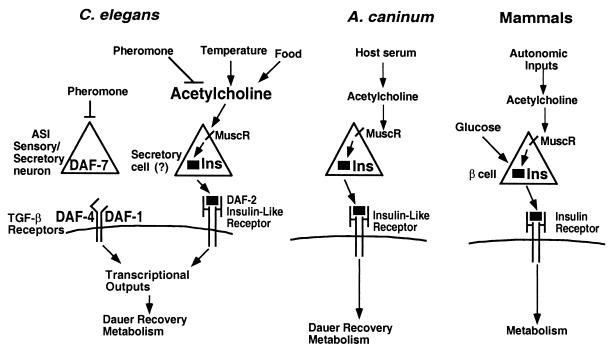Figure 3.
A model for cholinergic input induction of dauer recovery. In dauer pheromone or in a daf-7 mutant, the DAF-7 TGF-β ligand is not produced by the ASI sensory/secretory neuron. Therefore, there is no activation of the DAF-1 and DAF-4 TGF-β receptors or downstream DAF-8 and DAF-14 Smad proteins, and this results in high DAF-3 Smad activity in signaling cells or target tissues. In pheromone without muscarinic agonists, no insulin-like signal is released, causing less insulin receptor signal transduction to the transcription factor DAF-16, which, in combination with unregulated DAF-3, induces dauer arrest. Under pheromone-induced or daf-7 mutation-induced dauer induction conditions, muscarinic stimulation causes release of an insulin-like DAF-2 ligand, which stimulates the DAF-2/AGE-1-signaling pathway to DAF-16 inactivation. Because daf-7 mutants can recover in muscarinic agonists, the TGF-β signaling pathway is not required for dauer recovery. Under normal conditions of dauer recovery upon release from pheromone and addition of food and low temperature, we suggest that acetylcholine released via temperature or food pathways binds to the muscarinic receptor on the insulin-like signaling cell to cause an increase in insulin release. We suggest that temperature is coupled via the interneurons AIY and AIZ to the DAF-2 insulin-like signaling pathway rather than the TGF-β signaling pathway because mutations in the thermoregulatory gene ttx-3 can suppress mutations in daf-7 and not mutations in daf-2 (ref. 11; O. Hobert and G.R., unpublished observations).

